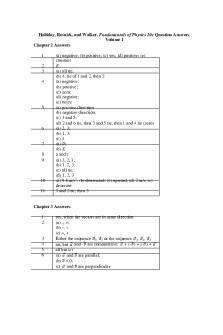Surface Area to Volume Ratio problems PDF

| Title | Surface Area to Volume Ratio problems |
|---|---|
| Course | Introduction to Biology |
| Institution | University of Hertfordshire |
| Pages | 3 |
| File Size | 92 KB |
| File Type | |
| Total Downloads | 53 |
| Total Views | 144 |
Summary
Download Surface Area to Volume Ratio problems PDF
Description
Introductory Biology
0FHH0022
Lesson 3 Worksheet 1
Surface Area to Volume Ratio The following questions focus on the relationship between surface area and volume ratio. You can use a calculator, but remember to include units in your answer. Abbreviations SA = Surface area Vol = Volume 1) A theoretical Biological cell takes the shape of a cube. It has the following dimensions; Height = 3 µm Width = 3 µm Depth = 3 µm Calculate the SA and Volume of the cell. Show your working. SA;
Vol;
2) The liver is made from two lobes (these are considered as cubes for this question), the left and right. Post-surgery following a trauma, a patient loses their left lobe. The dimensions of the lobes are as follows; Left lobe; Height = 3 cm Width = 4 cm Depth = 2.7 cm Right Lobe; Height = 9 cm Width = 8. 7 cm Depth = 2.7 cm
Introductory Biology
0FHH0022
Lesson 3 Worksheet 1
a) From the data, label the diagram as right and left lobes B) Calculate the total Vol of the liver Vol;
C) Calculate the SA and Vol of the right and left lobes Right; SA;
Vol;
Left; SA;
Vol;
D) What is the percentage change after the trauma surgery? Percentage change =
3) Scientists are working with patients who have undergone resections of their small intestine following Crohn’s Disease. Due to having to removal of sections of the small intestine, patients are losing body weight as they are unable to absorb the correct quantity of nutrients. They have made a model of the small intestine and are investigating the effect of different carbohydrate solutions and their absorption. Two solutions are under investigation, one a glucose only solution and one a glucose plus fructose solution. The trial uses 100g of each solution. The results are as follows;
Volume
Glu abs
GLU +
Introductory Biology of SI 10 20 30 40 50 60 70 80 90 100
4.7 9.3 12.7 17 21.2 25.5 25.3 25.4 25.2 25.1
0FHH0022
Lesson 3 Worksheet 1
FRU 4.6 9.7 12.3 16.6 21.8 25.9 29.8 33.5 33.7 33.6
Plot your results on a graph and calculate the gradient of the graph between 20 and 60 units of volume.
From your graph, what would you expect the absorption rate to be at 80 and 100 units of volume? How does this differ from what the scientists recorded? Comment on why this might be?
Extension; Can you find a biological explanation for why the rate of absorption between glucose and glucose + fructose solutions differ in the small intestine?...
Similar Free PDFs

Surface area of revolution
- 11 Pages

Ratio Analysis Solved Problems
- 34 Pages

Volume problems - spring
- 1 Pages
Popular Institutions
- Tinajero National High School - Annex
- Politeknik Caltex Riau
- Yokohama City University
- SGT University
- University of Al-Qadisiyah
- Divine Word College of Vigan
- Techniek College Rotterdam
- Universidade de Santiago
- Universiti Teknologi MARA Cawangan Johor Kampus Pasir Gudang
- Poltekkes Kemenkes Yogyakarta
- Baguio City National High School
- Colegio san marcos
- preparatoria uno
- Centro de Bachillerato Tecnológico Industrial y de Servicios No. 107
- Dalian Maritime University
- Quang Trung Secondary School
- Colegio Tecnológico en Informática
- Corporación Regional de Educación Superior
- Grupo CEDVA
- Dar Al Uloom University
- Centro de Estudios Preuniversitarios de la Universidad Nacional de Ingeniería
- 上智大学
- Aakash International School, Nuna Majara
- San Felipe Neri Catholic School
- Kang Chiao International School - New Taipei City
- Misamis Occidental National High School
- Institución Educativa Escuela Normal Juan Ladrilleros
- Kolehiyo ng Pantukan
- Batanes State College
- Instituto Continental
- Sekolah Menengah Kejuruan Kesehatan Kaltara (Tarakan)
- Colegio de La Inmaculada Concepcion - Cebu












